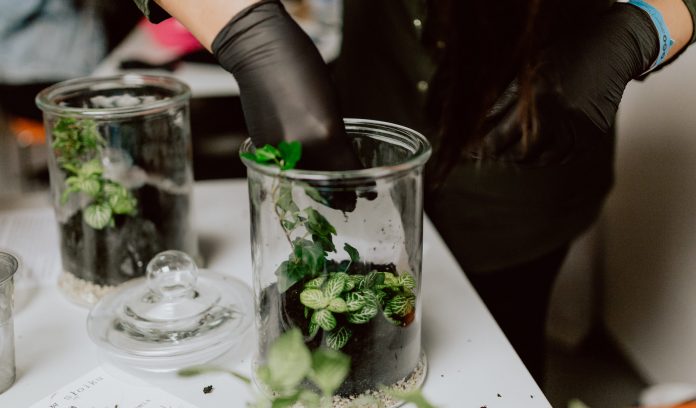Maybe it’s because we’re spoiled by green landscapes for most of the year in Northeast Ohio, but the winter months leave something to be desired for me. Anything that remains green after fall gets blanketed by snow. Although I acknowledge the needed period of rest for wildlife and native plant species, I still prefer to be surrounded by life.
Since moving into a house with a larger kitchen that has space above the cabinets I have acquired six new houseplants. It’s become my favorite room. With a west-facing sliding glass door, it gets the most natural light at the end of the day. Combine the effect of the sinking sun with the small jungle growing above the cabinets and it feels like an oasis.
While my kitchen is ideal for plant growth, not every room in my house gets enough sun or has enough room to support a mini jungle. Fortunately, closed terrariums don’t require a ton of space, climate control or direct sunlight to thrive.
If you have the winter blues, you can enhance any room in your home or office by designing, planting and maintaining a self-sustaining terrarium. They also make great gifts if you’re looking for ideas.
Closed terrarium supplies
A closed terrarium is essentially a miniature landscape with its own rain cycle. Compared to open terrariums and dish gardens, your plant and container choices are limited. However, unlike other setups, closed terrariums require minimal effort to maintain once they’ve been planted.
Containers. The container you choose will determine the size of the plants you can include in your terrarium. Make sure you choose something with sides that are higher than the plants you’re considering and an opening wide enough to fit them through. Additionally, terrarium containers should always be made of clear glass or plastic to allow enough light for plants to thrive. You can purchase a container specifically designed to be a closed terrarium or you might consider using repurposed glass cookie or candy jars, fish bowls, fish tanks, clear half-gallon canning jars and apothecary jars.
Terrarium tools. You can purchase terrarium tools or use items you have lying around the house. A long-handled spoon can be used as a substitute for a shovel. A cork, wrapped in a rubber band and attached to a chopstick can be used to pack down soil after planting. You can use scissors for cutting damaged or yellow leaves.
Potting mix. Terrariums require a soilless potting mix with low fertility. After you’ve purchased potting mix, mix in charcoal to add organic matter and absorb any chemicals or odors. You’ll need enough potting mix to fill your terrarium to the depth of the largest rootball of the plants you selected. When you prepare for planting the soil should be damp, but not soaking wet.
Choosing plants. Although succulents and cacti don’t make good closed terrarium plants, there are plenty of plant varieties that will work. Many of these plants fit into the categories of moist woodland and tropical. You should choose small, slow-growing or dwarf plants that fit into your container with room to spare. Moss, lichen and ferns are ideal for closed terrariums because of their ability to survive in dim, moist environments. Choose healthy plants with similar light and moisture requirements.
Planting your terrarium
Avoiding pests and diseases. The humid enclosed environments inside closed terrariums are perfect breeding grounds for pests and diseases. You should wash your hands or wear clean gloves before preparing and planting your terrarium. You should also clean your container with soapy water and allow it to air dry before planting. Additionally, if you notice any damaged or yellow leaves on your plants, remove them before planting.
Creating a design. You can choose to display only a single plant or many. If you included multiple plants in your terrarium, determining design depends on how your terrarium will be viewed — from all angles or from the front. If it’s only going to be viewed from the front, plant the tallest plant in the back and the smaller species in the front. If your terrarium is going to be viewed from all angles, the tallest plant should go in the center with the smaller plants blended around it. Consider your design before planting. It’s harder to change the design within the confined space of the terrarium.
Planting your terrarium. Once you’ve collected your materials and created your design, you’re ready to plant your terrarium. Make sure the soil is damp and start with the smallest plants first, leaving space for the larger plants as you go. Once everything is planted, clean off any dirty leaves and glass inside your terrarium with a clean, soft brush or paper towel.
Water. You’ll need to water your newly planted terrarium, but be careful not to over-water it. Misting you plants is one way to avoid over-watering. You can always add more water later, which is easier than trying to remove excess water. If there’s water on the foliage of your plants, leave the lid of your terrarium until it dries. Once lidded your terrarium should establish a rain cycle. You’ll notice condensation on the inside of the container, which rolls down to water your plants. The condensation should look like a light fog. Anything heavier is a sign you should remove the lid for a day or two to let it dry out some. Once the rain cycle has been established, your closed terrarium is almost maintenance-free.
Choosing a location. Now that your terrarium has been planted and is starting to become established, you’ll need to choose a permanent location for it. Bright rooms or near bright windows are preferred locations for most terrariums; however, many terrarium plants do well in dimmer rooms. If you determine your location beforehand, choose plants that can survive in the light offered in that location. If you choose your plants first, select a location that can accommodate the light requirements of your plants.
Maintenance
Removing the lid. Remove your terrariums lid once a week for up to 15 minutes to let in fresh carbon dioxide.
Watch for diseases. Because the environments inside closed terrariums are perfect breeding grounds for diseases, your terrarium can be devastated quickly if they’re not caught early. Check you terrarium a couple times a week and treat it with a diluted fungicide as soon as you notice infection.
Water. Only add water if you notice condensation has stopped, the plants start to droop, or the soil feels dry. If your container has a tight lid, this is only necessary every four to six months.
Rotate the container. If you notice your plants growing towards the light source, rotate your container to even them out.
Pruning. Prune plants when they are yellowing, touching the glass or getting too large.
Fertilizer. Once a year you may want to fertilize with an organic water-soluble fertilizer at 1/4 the recommended rate. Spring is an ideal time to fertilize. Never fertilize during winter.














I loved how you mentioned that you should remove your terrarium lid once a week to keep it clean. My brother is wanting to get some geckos for a pet and he was wondering how he could keep his terrarium clean. I’ll be sure to tell him to open his lid once a week to let it air out.
Well, if you get a gecko you will need a screen lid and that will let air circulate all the time.
Thank you for posting this. I will start with a 1 gallon jug, clear glass to learn how to do this. I have a 5 gallon clear glass jug (30 years old) that was a “Sparklets” fresh water container. That is my goal.
Question: If I encounter difficulties, how can I ask for advice? Is there another website or URL?
If I were to make a terrarium would it be a good science project, and will it take a month to become self sustaining or will I always have to care for it? Anyone can answer pls I just need some help. Thx
A terrarium would make a good science project as you’re essentially creating a closed ecosystem and have to understand how each part of it contributes to the survival of the organisms within. The only long-term maintenance required for a self-sustaining terrarium would be periodically adding nutrients/organic matter to the soil. In a natural setting, nutrients and organic matter are added when things die and decompose. Because this process is removed from a terrarium, you’ll have to amend the soil maybe once every six months.
I had a pedestal standing terrarium back in the 70’s when they were popular. I think I may start another one. I have recently begun raising a few succulents. I may try to interest my granddaughter in making a terrarium. Thanks for the info.